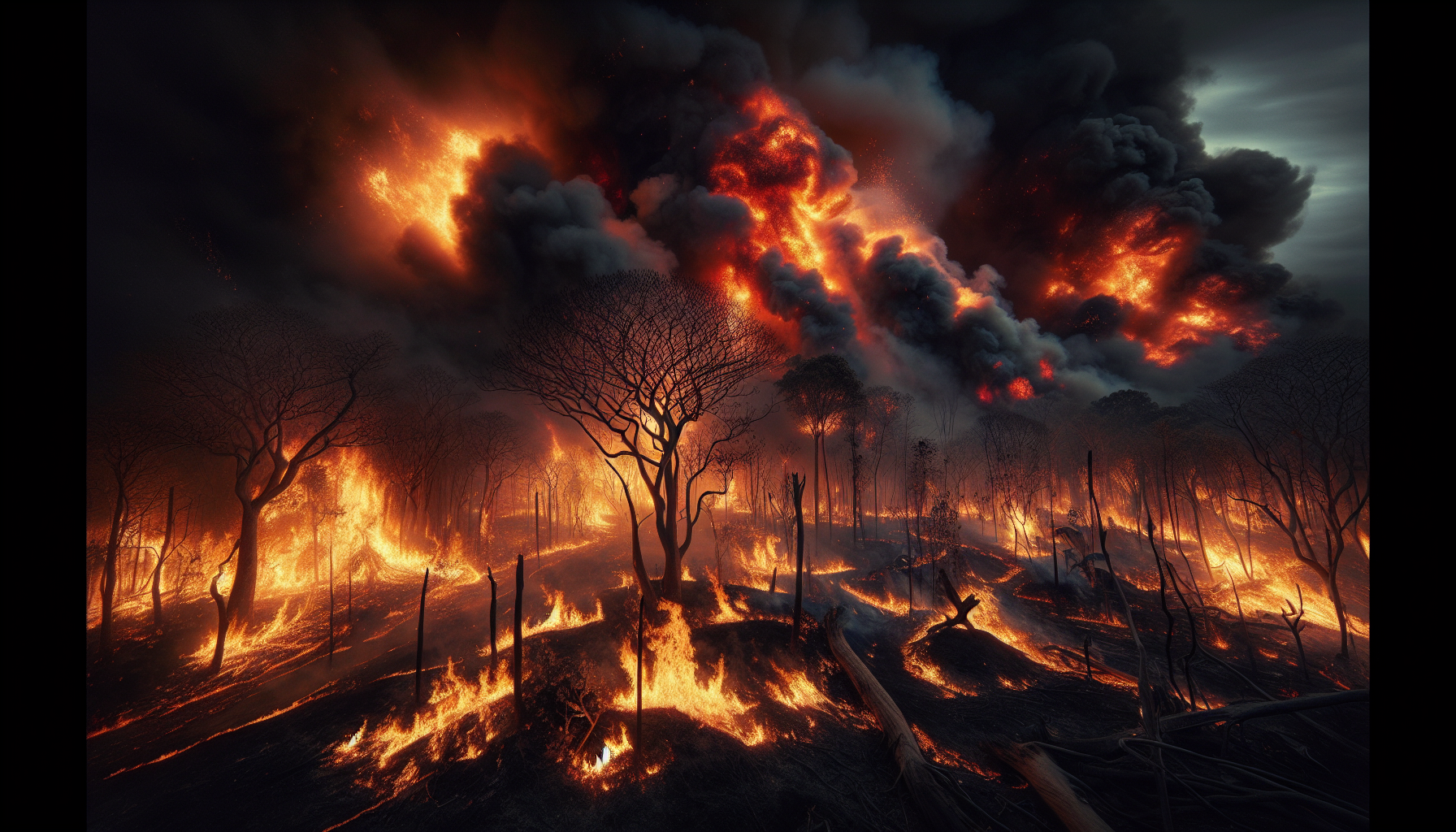In recent years, the world has watched in horror as towering infernos have raged across continents, leaving trails of destruction and despair in their wake. These relentless fires have become emblematic of a planet in distress, revealing the devastating impact of global fires and the insidious spread of soot, which together paint a grim picture of our environmental future. 🔥 From the verdant forests of the Amazon to the sunburnt landscapes of Australia, and the vast expanses of Siberia, no corner of the globe has been spared. As climate change accelerates and human activity continues to encroach upon natural habitats, the frequency and intensity of these fires have reached alarming levels, calling for urgent attention and action.
At the heart of this fiery crisis is a complex interplay of natural and anthropogenic factors. Rising global temperatures, prolonged droughts, and unpredictable weather patterns have created the perfect storm for wildfires to ignite and spread with unprecedented ferocity. However, while nature’s elements fan the flames, it is human negligence and industrial activity that provide the kindling. Unsustainable land management practices, deforestation, and the relentless march of urbanization have not only increased the likelihood of fires but also intensified their destructive power. As flames engulf forests, grasslands, and communities, they unleash a cascade of environmental consequences that extend far beyond the immediate devastation.
One of the most concerning byproducts of these raging fires is soot—those tiny black particles that result from the incomplete combustion of organic matter. Although they may seem innocuous, these particles pose a significant threat to both environmental and human health. Once released into the atmosphere, soot can travel vast distances, crossing borders and continents, and settling on ice caps, where it accelerates melting. Furthermore, soot contributes to air pollution, leading to respiratory illnesses and premature deaths. The impact is particularly severe in vulnerable communities, where access to healthcare is limited, exacerbating existing inequalities and perpetuating cycles of poverty and illness.
In this comprehensive exploration of global fires and their far-reaching consequences, we will delve into the science behind wildfires, examining the role of climate change and human activity in their escalation. We will also uncover the profound impact of soot on both the environment and human health, shedding light on the intricate connections between these fiery phenomena and broader ecological systems. Finally, we will consider the urgent need for global cooperation and innovative solutions to mitigate the devastating impact of fires and chart a path towards a more resilient and sustainable future. This journey into the heart of the infernos is not just an analysis of a global crisis; it is a call to action for all of us to become stewards of our planet and to embrace the responsibility of safeguarding its future. 🌍
The Origins and Causes of Global Fires
Global fires, often referred to as “raging infernos,” have become increasingly common and severe, affecting vast expanses of forested areas around the world. These fires can be sparked by both natural and human-induced factors, leading to devastating impacts on ecosystems, human health, and the global climate. Natural causes include lightning strikes and volcanic eruptions, while human activities such as deforestation, agriculture, and negligence play a significant role in igniting these flames. Understanding the origins of these fires is crucial for developing strategies to mitigate their impact and prevent future occurrences.
One of the primary natural causes of wildfires is lightning. When a lightning bolt strikes a dry area, it can easily ignite a fire. This is particularly common in regions that experience frequent thunderstorms, such as the western United States and parts of Australia. Lightning-caused fires tend to occur in remote areas, making them challenging to control and extinguish. Furthermore, climate change is exacerbating the frequency and intensity of thunderstorms, thereby increasing the likelihood of fires.
In addition to natural causes, human activities significantly contribute to the occurrence of wildfires. Deforestation for agricultural expansion and urban development often involves slash-and-burn techniques, where vegetation is intentionally set on fire to clear land. These fires can easily get out of control, especially during dry seasons, leading to widespread destruction. Moreover, negligence, such as leaving campfires unattended or improperly discarding cigarette butts, can also ignite fires. To address these human-induced causes, it is essential to raise awareness and implement stringent regulations and enforcement measures.
Environmental Impact of Fires and Soot
The environmental impact of global fires is profound and multifaceted, affecting air quality, biodiversity, and contributing to climate change. One of the most immediate effects of wildfires is the release of soot and other particulate matter into the atmosphere. Soot, composed of tiny black carbon particles, can travel long distances, affecting air quality far from the fire’s origin. When inhaled, these particles pose significant health risks, leading to respiratory problems, cardiovascular diseases, and even premature death.
Moreover, fires have devastating consequences for biodiversity. Forests are home to countless species of plants and animals, many of which are endemic and cannot survive outside their natural habitat. When fires sweep through these areas, they destroy vegetation and disrupt ecosystems, leading to loss of habitat and species extinction. For instance, the Australian bushfires of 2019-2020 are estimated to have killed or displaced nearly three billion animals, including iconic species such as koalas and kangaroos.
The impact of fires on climate change is also significant. When forests burn, they release stored carbon dioxide into the atmosphere, contributing to the greenhouse effect and global warming. This creates a vicious cycle where climate change increases the frequency and intensity of wildfires, which in turn release more carbon dioxide, further exacerbating climate change. Addressing the environmental impact of fires requires a multifaceted approach, including efforts to reduce carbon emissions, protect biodiversity, and improve land management practices.
Societal Consequences and Human Health
Beyond environmental impacts, global fires have severe societal consequences, affecting human health, livelihoods, and economic stability. The immediate danger posed by wildfires is the threat to human life and property. As fires spread rapidly, they can engulf homes, businesses, and infrastructure, leading to significant financial losses and displacement of communities. In recent years, regions such as California and the Amazon have experienced catastrophic fires, resulting in billions of dollars in damage and forcing thousands of people to evacuate their homes.
The health impacts of fires extend beyond immediate physical harm. The smoke and soot released into the atmosphere can travel vast distances, affecting air quality in areas far from the actual fire. Prolonged exposure to polluted air can cause respiratory illnesses, exacerbate asthma, and increase the risk of heart attacks and strokes. Vulnerable populations, including children, the elderly, and those with pre-existing health conditions, are particularly at risk. Public health campaigns and interventions are essential to educate communities about the dangers of fire-related air pollution and provide guidance on protective measures.
Additionally, the economic impact of fires is significant. The cost of firefighting efforts, property damage, and loss of productivity can strain local economies and government budgets. Tourism, a major source of income for many regions, can also suffer as natural landscapes are damaged and air quality deteriorates. To mitigate these societal consequences, it is crucial to invest in fire prevention and preparedness, strengthen emergency response systems, and support affected communities in recovery and rebuilding efforts.
Table: Comparison of Fire Causes and Effects
| Cause | Impact on Environment | Impact on Society |
|---|---|---|
| Lightning | Natural ignition source; increased frequency due to climate change | Remote areas affected; challenges in control and response |
| Deforestation | Loss of biodiversity; increased carbon emissions | Displacement; economic losses due to property damage |
| Negligence | Uncontrolled fires; damage to ecosystems | Health risks from air pollution; financial costs of firefighting |
Global Efforts and Solutions
Addressing the issue of global fires requires a coordinated international effort, involving governments, organizations, and communities. One of the key strategies is improving land management practices to reduce the risk of fires. This includes implementing controlled burns, which help reduce fuel loads and prevent larger, uncontrolled wildfires. Additionally, reforestation and afforestation efforts can help restore ecosystems and sequester carbon, mitigating the impact of fires on climate change.
International cooperation is also essential in addressing the cross-border impacts of fires and soot. Transboundary air pollution requires countries to work together to monitor air quality and implement measures to reduce emissions. The establishment of early warning systems and sharing of resources and expertise can enhance preparedness and response efforts. For instance, the ASEAN Agreement on Transboundary Haze Pollution is a regional initiative aimed at preventing and mitigating the impact of haze caused by forest fires in Southeast Asia.
Public awareness and education play a crucial role in preventing human-induced fires. Community engagement and education campaigns can help raise awareness about the risks of wildfires and the importance of responsible behavior. Encouraging sustainable land use practices and promoting fire-safe behaviors can significantly reduce the likelihood of fires. Governments and organizations can also leverage technology, such as satellite monitoring and fire prediction models, to detect and respond to fires more effectively.
Watch this informative video on the impact of wildfires:
Check out this video from National Geographic: “The Impact of Wildfires” by National Geographic. 📹
- Implement sustainable land management practices
- Enhance international cooperation and resource sharing
- Promote public awareness and education on fire prevention
- Leverage technology for monitoring and response

Conclusion
Raging infernos and the spread of soot have become a significant concern in our rapidly changing environment, as detailed in the article “Raging Infernos: The Devastating Impact of Global Fires and Soot on Our Environment.” Throughout this discussion, we’ve delved into the multifaceted impacts of wildfires and soot emissions, exploring their direct and indirect effects on ecosystems, human health, and the global climate.
Firstly, we explored the frequency and intensity of wildfires, which have escalated due to a combination of human activity and climate change. This upsurge in wildfire incidents is reshaping landscapes, destroying habitats, and threatening biodiversity. From the Amazon to the Arctic, no region is immune to these fiery catastrophes. The article highlights how the destruction of forests not only eliminates carbon sinks but also releases vast amounts of carbon dioxide and other greenhouse gases into the atmosphere, exacerbating global warming.
We then discussed the significant health implications of soot, a byproduct of wildfires, and its far-reaching consequences on air quality. Soot, or black carbon, is a potent pollutant that can travel long distances, affecting air quality even in regions far removed from the fire itself. This can lead to respiratory and cardiovascular issues, as well as other health complications, particularly affecting vulnerable populations such as children and the elderly. The discussion stressed the need for robust air quality monitoring and public health strategies to mitigate these health risks.
Additionally, the article examined the climatic effects of soot, emphasizing its role in atmospheric warming. When deposited on ice and snow, soot reduces their albedo, accelerating melting and contributing to sea level rise. This process is particularly troubling in polar regions, where ice melt is a critical concern for global climate stability. The feedback loop created by warming temperatures and melting ice further underscores the urgency of addressing these issues on an international scale.
Efforts to mitigate and manage wildfires were also covered, highlighting the importance of proactive measures such as controlled burns, improved land management practices, and community education. Emphasizing indigenous knowledge and sustainable practices can offer valuable insights into managing these natural phenomena more effectively. The article called for international cooperation and policy development to address these environmental challenges comprehensively.
In conclusion, the devastating impact of global fires and soot on our environment is an urgent issue that demands immediate action and sustained attention. The interplay between wildfires, soot emissions, and climate change creates a cycle that threatens not only ecosystems and biodiversity but also human health and global stability. It is imperative for individuals, communities, and nations to take collective responsibility and implement strategies that can help mitigate these impacts.
The information presented in this article aims to inspire and motivate you to act. Whether by advocating for policy changes, supporting conservation efforts, or simply raising awareness about the importance of addressing these environmental challenges, every action counts. We encourage you to share this article with others to spread awareness and foster a collective commitment to protecting our planet. 🌍
For further reading and research, you can explore the following resources:
1. [National Aeronautics and Space Administration (NASA) – Global Fire Monitoring](https://www.nasa.gov/mission_pages/fires/main/index.html)
2. [World Health Organization (WHO) – Air Quality and Health](https://www.who.int/news-room/fact-sheets/detail/ambient-(outdoor)-air-quality-and-health)
3. [United Nations Framework Convention on Climate Change (UNFCCC) – Climate Change and Wildfires](https://unfccc.int/topics/science/workstreams/cooperation-with-scientific-organizations/fire-and-climate-change)
We invite you to reflect on the insights shared in this article and consider how you can contribute to a more sustainable and resilient future. Share your thoughts and ideas in the comments, engage with your community on these topics, and let’s work together towards a healthier planet. 🌱
Toni Santos is a visual storyteller and ecological artisan whose work delves into the haunting beauty of extinct biomes — landscapes that once thrived with life, now lost to time. Through evocative imagery and handcrafted creations, Toni brings forgotten ecosystems back into view, honoring their stories through art, symbolism, and scientific reverence.
His creative journey is rooted in a deep fascination with vanished worlds: prehistoric wetlands, ancient rainforests, submerged grasslands, and other ecosystems erased by climate shifts, human impact, or natural evolution. Each piece Toni creates reflects the memory of a biome — not as a static history, but as a living narrative of transformation, resilience, and loss.
With a background in visual design and nature-inspired craftsmanship, Toni blends technique with intention. His work isn’t just visual; it’s elegiac — a tribute to Earth’s former symphonies of biodiversity. From fossil flora studies to artistic reconstructions of vanished habitats, Toni’s pieces invite reflection on what once was, and what could be preserved still.
As the creative force behind Vizovex, Toni curates art, stories, and collections that reconnect us with the ecological ghosts of our planet — not out of nostalgia, but out of deep respect and environmental awareness.
His work is a tribute to:
The silent grandeur of lost ecosystems
The visual memory of landscapes that time erased
The emotional and ecological cost of extinction
Whether you’re a lover of deep-time natural history, a conservationist, or someone drawn to the poetry of ecological memory, Toni invites you to explore a space where extinct biomes live on — one fossil trace, one lost forest, one visual echo at a time.




